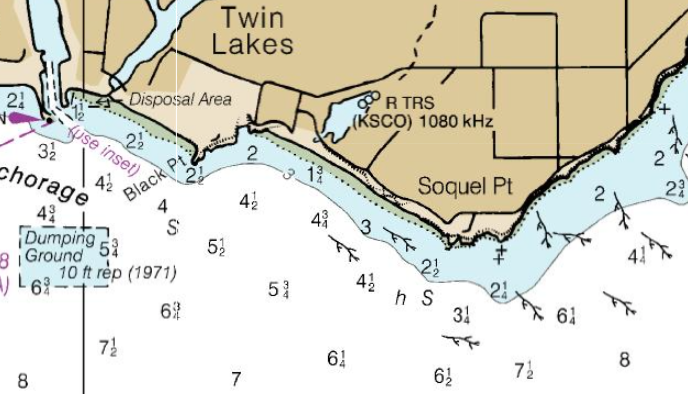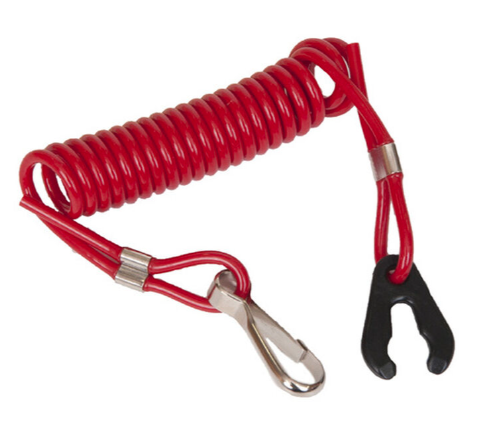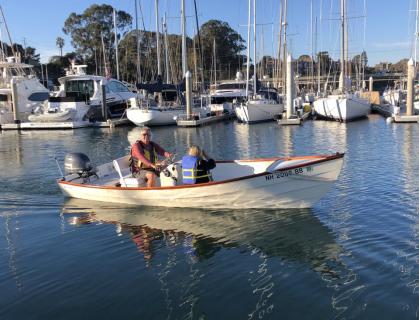New Boat Jitters: Excitement is No Excuse
“From the CCA School of Hard Rocks
...lessons learned in pursuit of the Art of Seamanship”
By Chuck Hawley, San Francisco Station, 12/01/23
The excitement of a new boat, even after you’ve toiled over it to prepare for its maiden voyage, should not be an excuse to neglect your safety preparation, nor forget your operational checklists. However, many of us get tempted by the lure of the ocean, and the excitement of trying out a new vessel. Such was the position I found myself after taking delivery of a 20-year-old Bristol Skiff, which had been towed across the country by a friend who apparently wanted to escape Fall Colors and instead see giant redwoods.
After a week of cleaning, splicing a lifting bridle so she could be hoisted into the harbor, checking over the nearly new 40HP outboard, and re-fastening the center console to the sole with larger screws, Susie was ready for launch. Onboard was the required Coast Guard safety gear: life jackets, a fire extinguisher, and a throwable cushion. Missing, however, was a trio of flares, required since we were going out on the open ocean, a VHF radio, a PLB or EPIRB, a paddle, or virtually anything else of use in an emergency. But the day was crisp, visibility was excellent, and the wind was virtually calm. What could go wrong?
I headed out of the harbor, and turned east along the coast, looking for otters, sea lions, migrating pelicans, and other residents of the largest marine sanctuary in the U.S. At some point, I was about a quarter mile offshore when I ran into a particularly thick patch of giant brown kelp, or macrocytis pyrifera. Said to be the fastest growing plant in the world, this algae is the home to sea otters, sea birds, and shellfish, but a challenge to keels, rudders, and propellers. Susie bogged down, a sure sign that I had wrapped some kelp around her propeller. I pulled the throttle to an idle, and pivoted in my seat to see how much kelp I was dragging.

The “emergency engine cutoff switch” or “kill switch” immediately stopped the engine as I looked aft, just as it was intended to do. Seeing a small amount of kelp trailing astern, I replaced the stop switch lanyard, and turned the key to restart the engine.

Nothing happened. The key turned, but there was silence from the engine. I removed and replaced the stop switch lanyard to reseat it. The engine remained silent. I turned to inspect the wiring on the single 12V battery to see if something had come loose. The connections were tight. And I had plenty of gas.
I considered my options. No VHF radio (and whom would I call? TowBoatUS? The harbormaster?) No flares. No paddle. While I did have an anchor and rode, it was an off-brand lightweight anchor that came with the boat, and it looked incapable of holding the boat in place. I’d have a better chance by tying the boat to the kelp that surrounded it.
Add to this that it was a weekday, and there was virtually no vessel traffic in my vicinity. I thought of my iPhone in my pocket. Whom could I call who would keep a secret about towing me to the harbor with his sailboat? That was a solution that would be very far down my list of options. I’d never hear the end of it. I imagined the headlines in the yacht club newsletter: Safety Expert Gets Towed by Sailboat During Maiden Voyage. I figured that I would take my chances getting swept onto the beach.
My last possible solution was to jiggle the throttle lever to see if it made a difference. As I moved it, it clicked into neutral and locked in place. The same neutral that you use when starting your engine to prevent you from running over the dock in front of you. I turned the key. The engine quickly started and idled happily. I cleared the prop with a quick forward-then reverse-then-forward gear shift change, and fragments of kelp floated astern. Then I aimed for open water, away from the kelp, and accelerated onto a plane.
What did I learn from this?
- Avoid kelp. It’s home to lovely sea creatures, and not a good place to go boating.
- Use a checklist, even on simple things. Launching, starting the engine, gear you should have on board, putting the boat away. Even if the checklist is four items, it can remind you that the boat needs to be in neutral…
- Don’t convince yourself that “it’s only a quick trip” or “I’ll bring the handheld radio next time.” You need to be prepared to be self-sufficient every time you go boating, and to be able to get help when you fail at being self-sufficient.
The Cruising Club of America is a collection of passionate, seriously accomplished, ocean sailors making adventurous use of the seas. All members have extensive offshore boat handling, seamanship, and command experience honed over many years. “School of Hard Rocks” stories, published by the CCA Safety and Seamanship Committee, are intended to advance seamanship and help skippers promote a Culture of Safety aboard their vessels.






